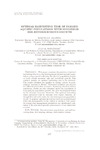Identificador persistente para citar o vincular este elemento:
https://accedacris.ulpgc.es/jspui/handle/10553/23169
| Campo DC | Valor | idioma |
|---|---|---|
| dc.contributor.author | Araneda, Marcelo E. | en_US |
| dc.contributor.author | Hernández, Juan M. | en_US |
| dc.contributor.author | Gasca Leyva, José Francisco Eucario | en_US |
| dc.contributor.other | Gasca-Leyva, Eucario | - |
| dc.contributor.other | Hernandez, Juan | - |
| dc.date.accessioned | 2017-08-18T02:31:05Z | - |
| dc.date.accessioned | 2018-03-15T14:37:38Z | - |
| dc.date.available | 2017-08-18T02:31:05Z | - |
| dc.date.available | 2018-03-15T14:37:38Z | - |
| dc.date.issued | 2011 | en_US |
| dc.identifier.issn | 0890-8575 | en_US |
| dc.identifier.uri | https://accedacris.ulpgc.es/handle/10553/23169 | - |
| dc.description.abstract | This paper examines the question of optimal harvesting time in a size‐heterogeneous farmed aquatic population, using a model reflecting the effect of population density on both overall mortality rate and individual growth. This analysis enables an optimal harvesting rule to be deduced. The results obtained are applied to shrimp culture in recirculation systems in Mexico. Numerical solutions are derived for different production scenarios. Assuming identical culture conditions, results are also obtained under the hypothesis of homogeneous population growth, the view traditionally taken in the relevant economic literature. The optimal harvesting times calculated tend to decrease with higher densities, although this rule fails under the size‐heterogeneous population model. In general, optimal harvesting times are overestimated when size‐homogeneity in the culture is assumed. Our analysis reveals that management predictions are significantly mistaken if the size‐heterogeneity phenomenon is not taken into account. | en_US |
| dc.format | application/pdf | es |
| dc.language | eng | en_US |
| dc.relation.ispartof | Natural Resource Modelling | en_US |
| dc.rights | by-nc-nd | es |
| dc.source | Natural Resource Modeling [ISSN 0890-8575], v. 24 (4), p. 477-513 | en_US |
| dc.subject | 53 Ciencias económicas | en_US |
| dc.subject.other | Size-structured populations | en_US |
| dc.subject.other | Optimal harvesting time | en_US |
| dc.subject.other | Fish farming | en_US |
| dc.subject.other | Shrimp | en_US |
| dc.subject.other | Recirculation system | en_US |
| dc.title | Optimal harvesting time of farmed aquatic populations with nonlinear size-heterogeneous growth | en_US |
| dc.type | info:eu-repo/semantics/Article | en_US |
| dc.type | Article | en_US |
| dc.identifier.doi | 10.1111/j.1939-7445.2011.00099.x | |
| dc.identifier.scopus | 80255138243 | - |
| dc.identifier.isi | 000296131700003 | - |
| dcterms.isPartOf | Natural Resource Modeling | |
| dcterms.source | Natural Resource Modeling[ISSN 0890-8575],v. 24 (4), p. 477-513 | |
| dc.contributor.authorscopusid | 24474302800 | - |
| dc.contributor.authorscopusid | 7403026151 | - |
| dc.contributor.authorscopusid | 6602639684 | - |
| dc.identifier.crisid | -;-;- | - |
| dc.identifier.eissn | 1939-7445 | - |
| dc.description.lastpage | 513 | - |
| dc.identifier.issue | 4 | - |
| dc.description.firstpage | 477 | - |
| dc.relation.volume | 24 | - |
| dc.investigacion | Ciencias Sociales y Jurídicas | en_US |
| dc.rights.accessrights | info:eu-repo/semantics/openAccess | es |
| dc.type2 | Artículo | en_US |
| dc.identifier.wos | WOS:000296131700003 | |
| dc.contributor.daisngid | 5718978 | - |
| dc.contributor.daisngid | 1765491 | - |
| dc.contributor.daisngid | 1889769 | - |
| dc.identifier.investigatorRID | J-8413-2016 | - |
| dc.identifier.investigatorRID | D-7096-2013 | - |
| dc.contributor.wosstandard | WOS:Araneda, ME | |
| dc.contributor.wosstandard | WOS:Hernandez, JM | |
| dc.contributor.wosstandard | WOS:Gasca-Leyva, E | |
| dc.date.coverdate | Noviembre 2011 | |
| dc.identifier.ulpgc | Sí | es |
| dc.description.sjr | 0,314 | |
| dc.description.jcr | 0,556 | |
| dc.description.sjrq | Q3 | |
| dc.description.jcrq | Q4 | |
| dc.description.scie | SCIE | |
| item.grantfulltext | open | - |
| item.fulltext | Con texto completo | - |
| crisitem.author.dept | GIR TIDES: Economía, medioambiente, sostenibilidad y turismo | - |
| crisitem.author.dept | IU de Turismo y Desarrollo Económico Sostenible | - |
| crisitem.author.dept | Departamento de Métodos Cuantitativos en Economía y Gestión | - |
| crisitem.author.orcid | 0000-0001-6897-5179 | - |
| crisitem.author.parentorg | IU de Turismo y Desarrollo Económico Sostenible | - |
| crisitem.author.fullName | Hernández Guerra, Juan María | - |
| Colección: | Artículos | |
Citas SCOPUSTM
21
actualizado el 08-jun-2025
Citas de WEB OF SCIENCETM
Citations
21
actualizado el 08-jun-2025
Visitas
144
actualizado el 31-oct-2024
Descargas
270
actualizado el 31-oct-2024
Google ScholarTM
Verifica
Altmetric
Comparte
Exporta metadatos
Los elementos en ULPGC accedaCRIS están protegidos por derechos de autor con todos los derechos reservados, a menos que se indique lo contrario.
